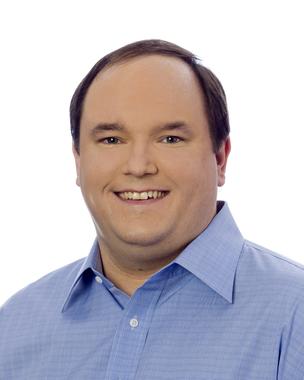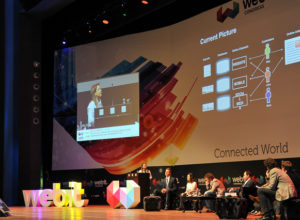Online Identity, Security and Fraud
Storytelling as a lifestyle
Social media – as much as possible
Using social media is a requirement in today’s business climate, so it will be one of the focuses on the 6th Webit Global Congress. Sandy Carter, the author of ‘Be Bold!’ and General Manager, IBM Ecosystems and Social Business Evangelism at IBM is one of the lectors who will discuss the topic Social media.
 A recognized leader in social business, Sandy is responsible for IBM’s worldwide focus on building ecosystems around the core growth areas of social, mobile, cloud, big data and analytics. She is an award-winning author of three books, including best-selling “Get Bold”, and has received numerous social media awards: “Top 10 in Social Media" by Altimeter Group, "Top 50 Social Business Influencers" by Biz Imagined Group (UK), "Brand Leader of the Year" from the World Brand Congress, #1 Social Influencer at 2014 IBM Pulse Cloud conference, and one of the "Most Powerful Women in Technology” by CNN Magazine and Fast Company.
A recognized leader in social business, Sandy is responsible for IBM’s worldwide focus on building ecosystems around the core growth areas of social, mobile, cloud, big data and analytics. She is an award-winning author of three books, including best-selling “Get Bold”, and has received numerous social media awards: “Top 10 in Social Media" by Altimeter Group, "Top 50 Social Business Influencers" by Biz Imagined Group (UK), "Brand Leader of the Year" from the World Brand Congress, #1 Social Influencer at 2014 IBM Pulse Cloud conference, and one of the "Most Powerful Women in Technology” by CNN Magazine and Fast Company.
Sandy describes herself as a very execution focused person with innovation and creativity driving her focus areas.
The book ‘Get bold!’ offers a systematic approach to creating and implementing an effective and successful social media strategy for your business. Using the author’s “AGENDA” you can boldly take your business forward. What is that agenda?
A - Aligning your goals and culture to be ready to become more engaging and transparent.
G – “Gain Friends through Social Trust” focuses on finding your fans, friends and followers, and forming best friends from your tippers or most influential clients or outside parties.
E – Engage through experiences focuses on how a company can engage its clients and employees and dives into gaming, virtual gifting, location based, mobile, or other stellar experiences to drive that engagement.
N – Network your processes. Since this is about business, figuring out how to add social to your processes is critical.
D – Design for Reputation and Risk Management! This is the #1 areas of focus for the C level — managing the risk of having your brand online
A – Analyze your data! Social analytics are the new black!
You can learn a lot from Sandy Carter about Social and the 6th edition of Webit Global Congress is the perfect moment. Book your tickets with early bird prices now.
The Future of Big Data, Big Cloud and Connected Devices
Connected Devices at Home
Consumers are using more and more mobile devices in their everyday life. Smartphones and tablets are connecting us to the world around us. The new trend of "wearable "connected devices are linked to our mobile phones and tablets and can measure and transmit via sensors all kind of data. At home, we see ordinary devices like thermostats, lights, garage doors and kitchen appliances all becoming "smart". These devices are connected and can be controlled with a smartphone. They have the ability to autonomously adjust settings, alert users based on information and sensors from other devices both within the home or on our wrist. All these connected devices interact with each other and create Data. Lots of it.Connected Devices at the Enterprise
At the enterprise level, the trend is of using smartphones and tablets for business needs. Enterprises see this as an excellent way to increase employee effectiveness. This creates a lot of data and enterprises are looking for ways to use all this accumulated data for its business needs. To add to all this many industrial devices are also being connected and this is a future trend. Again, this creates data, big data.Big Data and Big Cloud
All data that we see accumulated has to be useful for both the consumer and the enterprise. It has to be stored, analyzed and automated. The Internet of Things (IoT) is creating a completely new ecosystem of interconnected devices both at home at the enterprise and all around us. In addition, all these connected smart devices are creating Big Data that is being stored in the cloud. The challenges ahead are how to make all this data useful. We are just in the beginning with many challenges ahead in making this data useful. It is not surprising that companies like IBM, Cisco, Qualcomm Ventures, Intel, Microsoft, Amazon, Google and many others are looking at real time solutions to store, share, analyze and automate this Big Data in the Big Cloud. At the blue track of the Webit influential Founders, CTOs, CIOs of the worlds most innovative companies; disruptive startups, top talents, over 400 investors and 300 accredited media will take part in the Leaders of the Future tech discussion. Join them and get an early bird ticket now!Mariano A. Bosaz, The Coca Cola Company: Why is failure so...
 Mariano A. Bosaz is Group Digital Director Eurasia Africa of Coca-Cola Company. He is amongst the winners for speakers of Webit with 2615 votes. Let us remind you that more than 53 123 people joined Webit competition of Webit Audience Choice Speakers voted for 312 candidates to join the amazing speakers of the Global Webit Congress 2014.
Mariano A. Bosaz is Group Digital Director Eurasia Africa of Coca-Cola Company. He is amongst the winners for speakers of Webit with 2615 votes. Let us remind you that more than 53 123 people joined Webit competition of Webit Audience Choice Speakers voted for 312 candidates to join the amazing speakers of the Global Webit Congress 2014.
Webit: Mr Bosaz, are you excited that you are among the winners at audience award to be on the stage of GWC so 10 000 visitors from EMEA and ASIA will be able to hear your thoughts and you will share your experience with them?
M.B.: I am excited as I am also keen to participate in Webit. This congress is not only one of the most important in the region but also known Worldwide. So I am looking forward to attend.Webit: During the contest they were really big names in the digital and tech industry worldwide so what was the feeling to compete?
M.B.: I spent time going through the list of candidates and felt that I would have loved to listen to some speakers. They have a lot of experience and as you said big names in the industry. I felt it less as a competition and more as a better way to let people choose key-note speakers and make participation more social.Webit: What was your motivation to apply for a speaker at Webit and What are your expectations from the 6th Webit Global Congress?
M.B.: Honestly, I received an email about the upcoming event in Istanbul and a link to apply as keynote speaker. Since I knew about Webit and I did not have direct contact with the organizers, I thought it was a good idea to see if people wanted to listen to me. After some time, when I checked the site again, I had more than 1,000 votes and it was shocking because I did not push any communications from my side.Webit: We have more than 300 media from all around the world there that are very curious for news and launches so please share with us in before just a part of your topic so to keep it hot.
M.B.: My topic is around failure. In the last 5 years, some digital companies started to develop a culture of tolerance towards failure. Yahoo, Google and Facebook are probably well-known because they have failure as part of their company principles. So I would like to discuss what is failure, why it is good for some, how much can companies “pay for failure” and the ROI of failure. I will illustrate with some recent examples during Football World Cup and onwards.Webit: Who would you advise to attend Webit Global Congress and why?
M.B.: I am inviting our Marketing, Brand and Media Directors. They are key players in our industry from a planning and budget perspective. They lived the transformation of the world in the last 15 years and they are the C-levels of the next decade. Hurry up and book your ticket for 6th Webit Global Congress today!From PC to mobile – the game changers
Can Europe beat Silicon Valley?
 Dmitry Chikhachev is a professional venture capitalist with more than 18 years of extensive cross-functional experience. Dmitry holds an MS degree in Applied Mathematics and Physics from the Moscow Institute of Physics and Technology. He also completed an MBA curriculum, graduating with highest honors from the American Institute of Business and Economics.
His investment interests span complex software, mobile, virtualization and could computing. He led deal execution for NGINX, Jelastic, LinguaLeo, Ecwid, Cellrox, Capptain and other Runa companies.
Dmitry is a ‘hands on’ investor and helps portfolio companies with fundraising, recruitment, strategy and technology. Just recently, Dmitry and partners launched the $200M Runa Capital Fund II looking to invest in the best tech-companies across the Globe.
At the blue track, Dmitry will focus his talk on the power of the European educational system. The role it has in tech. He will also talk on the increasing capital flow to Europe and the opportunities investors are looking for in Europe, the emerging and fading trends.
Here is what Dmitry shared with us:
Dmitry Chikhachev is a professional venture capitalist with more than 18 years of extensive cross-functional experience. Dmitry holds an MS degree in Applied Mathematics and Physics from the Moscow Institute of Physics and Technology. He also completed an MBA curriculum, graduating with highest honors from the American Institute of Business and Economics.
His investment interests span complex software, mobile, virtualization and could computing. He led deal execution for NGINX, Jelastic, LinguaLeo, Ecwid, Cellrox, Capptain and other Runa companies.
Dmitry is a ‘hands on’ investor and helps portfolio companies with fundraising, recruitment, strategy and technology. Just recently, Dmitry and partners launched the $200M Runa Capital Fund II looking to invest in the best tech-companies across the Globe.
At the blue track, Dmitry will focus his talk on the power of the European educational system. The role it has in tech. He will also talk on the increasing capital flow to Europe and the opportunities investors are looking for in Europe, the emerging and fading trends.
Here is what Dmitry shared with us:
" It is clear that the old school investment teams are changing. As entrepreneurs take place as VCs, especially in Europe, their deep tech expertise can influence the funding approach. We should look into the hard-tech technology and see its market potential, speak common language with entrepreneurs.Meet Dmitry at the sixth Webit Global Congress, and book your tickets with the early bird prices!
Media trading future trends
Consolidation as a means of accumulation?
Nowadays, if you are a big publisher you would need to work with either Amazon, or Apple, or Google. They have done amazing things for the publishing sector, but at the same time they are dictators and monopolists, and you either find other ways of trading or you find ways of standing up to the dictats. Both require versatility, which smaller publishers are probably better placed to benefit from, strength of market position (not to be lost to competitors), which the mergers are aiming to achieve, and cash investment.Everything is `APPening online!
This is a progressive trend, that you are not able to stop or take back. The only option is to adapt in order to stay on the market. Various applications, various services. A clear side-effect of this will be a move from device-based apps to web-based apps will lots of content and tools. This way the focus is on end-user satisfaction, so you will just need to invest once to monetize content for numerous platforms.The rising importance of RTB video
Video advertising is a more than a trend nowadays and when we combine this RTB, we get the rising importance of RTB video. A key driver of brand advertiser application of RTB has been the rising availability of online video advertising via RTB ad exchanges. With this growth, we can expect that more advertisers will plan their online video investments in conjunction with TV advertising and to experiment with “programmatic” TV buying. You will learn more about the media trading future trends at the 6th Webit Global Congress. Book your tickets with early bird prices now!Dane Glasgow – eBay and the future of eCommerce
One of the first websites (or even the first) we associate with the term eCommerce is Ebay. This is the place that customers believe in and come back. Dane Glasgow is one of the people behind the scenes, who is working hard in order to build this credibility. It is our pleasure to present one of the speakers of Webit Global Congress.
Dane Glasgow serves as Vice President, Global Product Management for eBay Marketplaces, and brings more than 15 years of experience leading product design and development, innovation in search technology, and management to the world’s largest online marketplace. In his role, Dane focuses on delivering a compelling shopping experience globally for both buyers and sellers. Dane previously served as eBay’s vice president of engineering, where his team brought an increased level of structure and depth to the eBay Global Product Catalog.
 Dane joined eBay in December of 2008 through the acquisition of Positronic, a company he co-founded in Seattle. Positronic developed a sophisticated machine learning and natural language processing platform in the finance sector. As Positronic’s chief technology officer, Dane set the software vision – driving the architecture and roadmap to achieve positive results. Positronic’s technology and team were integrated into eBay following the acquisition.
Dane joined eBay in December of 2008 through the acquisition of Positronic, a company he co-founded in Seattle. Positronic developed a sophisticated machine learning and natural language processing platform in the finance sector. As Positronic’s chief technology officer, Dane set the software vision – driving the architecture and roadmap to achieve positive results. Positronic’s technology and team were integrated into eBay following the acquisition.
Before co-founding Positronic, Dane was the director of program management at Microsoft for the Live Search product, leading a talented team of program managers who were responsible for delivering fast, relevant Search to customers throughout the world. In coordination with the development and test organizations, the team created the Web Search experience for Microsoft through MSN.com, Microsoft.com, and Live.com, including offerings for searching Web pages, Images, News, Products, Videos, and Blogs.
Prior to working on Live Search, Dane served as the general manager for the Windows Live Portal & Client team. The group developed software ranging from the Live.com portal, which placed users at the center of their information experience, to the MSN Search Toolbar, which offered significant browsing and search enhancements for Internet Explorer. In this role, Dane delivered near-instant search results for files and email on users' PCs through Windows Desktop Search. Dane also drove the acquisitions of Lookout Software, a provider of fast email searching for Microsoft Outlook, and Onfolio, a company delivering tools for browser-based research and information management. The team went on to ship Windows Live Writer, a desktop blog publishing application.
Previously, he helped launch MS Ideas, an internal site dedicated to helping employees post, discuss, and collaborate on new product ideas and technologies. Dane also served as Group Manager of MSN Calendar - which provided calendaring, task management, and notifications in numerous languages through MSN Hotmail.
Dane joined Microsoft in April 1999 through the acquisition of Jump.com, a company he helped create in Ithaca, N.Y.
Dane attended Cornell University, where he studied computer science, business, and fine arts. Outside of the office, he enjoys photography, computer graphics, amateur high altitude ballooning/rocketry, robotics, helping educational and scientific-based charities, and driving fast cars. Dane serves on the board of trustees for the SETI Institute.
An expert with consistent experience, Dane is a person you must know since he can teach you a lot about e-commerce. Meet him at the 6th Webit Global Congress, but before book your tickets with the early bird prices!
New marketing mix models: S.A.V.E. replaces the 4 P’s
‘Solve their problem better than anyone else and you'll end up with a product your customers can't live without.’ - Ruben GamezA. is for Access. It is not about the place, it is not about whether it will be online or offline, your customers need your business to be accessible and you should provide them with it. You choose how.
‘What can a brand give me at this precise moment that I want or need? That's the bar companies now have to clear, and it's not easy.’ - Jay BaerV. is for Value. Customers care about the price, it is natural, but before the price come the concerns about the value. Are the benefits of your product relevant to the price you define?
‘When we hear customers say that our product is too expensive, before wondering if we should lower the price we are more concerned with whether we should increase our product's value.’ - Walter ChenE. is for Education. Your audience need and want to be informed. The number of businesses with online presence grows daily as well as the importance of attraction-based marketing.
“Simply because providing someone with free, and useful information, creates a much stronger bond and connection than any banner ad or press mention ever could." Leo WidrichThe S.A.V.E. framework is the modern look at the traditional 4P’s Theory and is inspirerd by the circumstances. Lots of marketing and digital experts will be at the 6th Webit Global Congress to discuss the new trends. In order to follow them, apply now!








